Thursday 22 October 2015
White: K. Nevols - Black: D Fowler (145)
For the third time we faced Snodland - this is because we are opposing them in two different tournaments - but thankfully as both board orders chopped about a bit, I faced three different opponents - and each time with the white pieces.
1. d4 e6
2. c4 Nf6
3. Nc3 c5
4. d5 exd5
5. cxd5 d6
This is the Modern Benoni. A rather odd opening, in my view, as Black's pawn on d6 just looks strange but many great players have made success of this counter attacking opening. The idea is for Black to attack with the majority of pawns on the queenside helped by a bishop on g7. White in turn has opportunities in the centre leaning on e4-5.
As with most openings, I do not know a great deal about it. After pondering Nf3, I think, what the hell, and play a line which I saw in the past and looked quite dangerous (which I read afterwards is called the Taimanov variation).
6. e4 g6
7. Nf3 is the most common here.
7. f4 Bg7
8. Bb5+
The point is that Bd7 and Nbd7 both allow e5 where White can get some advantage.
8. ... Nfd7
9. a4
The point of a4 is to hold up White's queenside play.
9. ... O-O
Black's most common reply. 9. . Na6 has also been seen with the idea of either Nc7 or Nb4. There is also the idea of 9. .. Qh4+ 10. g3 Qe7 to weaken White slightly.
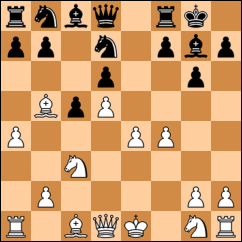
10. Nf3 a6
11. Bd3
Unknown to me, we were still in theory, but then White tends to put his bishop on e2 and not d3. My point here is that I was concerned about f5, but on d3 Black has a future option of a c4 with a tempo. Also a bishop on e2 has a possibility of moving to the f3 square which would add impetus to any e5 push.
(The computer prefers Bd3. After 11. Be2 it gives 11. ... Bxc3+ 12. bxc3 Nf6 with attacks on the central pawns. However would a human Benoni player give up his bishop so early?)
11. ... Nf6
12. O-O Bg4
OK so far. Now I wanted to free my position a little to get an attack rolling.
13. h3 Bxf3
14. Qxf3 Nbd7
15. g4
15. a5 might be better to prevent Qa5 and continue clamping down on the left wing. However I wanted to get on with it.
15. ... Qc7
16. Qg3?
My plan is the straight forward clubbing one of bashing through to the king. I am thinking Qh4 and f5. But I have overlooked a tactic. I should have played 16. Kh1 by this stage.
16. .... c4
17. Bc2
Defending against Nc5-b3.
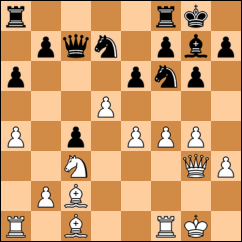
17. ....... b5!
I completely missed this! Black has chosen the right moment to unleash the b-pawn, cause carnage and grab the initiative. Obviously I cannot take twice on b5 losing the knight to Qb6+. Having said that 17. ... Nc5 is still good.
18. axb5?
Still shocked, I add another error. I thought opening the a-file might be to my advantage, but Black has some tactics coming up which means it is he who can use the file.
18. .. axb5
The time limit is 35 moves in 75 minutes and then 15 minute for all the rest. Black here has 34 minutes left for 17 moves.
19. Be3
Grabbing the diagonal and connecting the rooks. I had 38 minutes left for 16 moves.
19. .. Qb7
20. Qf2
To stop Nb6. This is a good example of psychological chess. Having missed 17. .. b5 and now seeing Black's advances on the queen side, I am assuming I am losing and have now switched to 'grim defence' mode. However, 20. e5! is good for White. If 20. .. Ne8 (breaking the connected rooks) 21. Rxa8 Qxa8 22. e6 fxe6 23. dxe6 Nc5 24. Nxb5 Nxe6 25. f5 and it is White on the front foot.
20 .... b4
21. Ne2 b3
Now I have to surrender the a-file in order to save material and the bishop assumes a miserable position.
22. Rxa8 Rxa8
23. Bb1 Ra6!
While Black was thinking I now saw 23. .. Nxe4!? 24. Bxe4 Bxb2. Black has two pawns for the piece and two passed pawns. I pondered and tried to see how I could defend. If 25. Bd4 then 25. .. Bxd4 26. Qxd4 Nc5 27. Nc3 Nxe4 28. Qxe4 Qb4. Or 26. Nxd4 c3. It all looked quite grim.
The main idea I looked at was 25. f5 to see if I could break through on the f-file. Black could try 25. ... Ne5 or 25. .. f6!? 26. fxg6 hxg6 27. Bxg6 Qxd5 but then 28. Qh4 looks good. Perhaps Black can simply play 25 .... Rf8 or 25. ... Ra1 to exchange the rook. 25. ... Nf6 is another simple option.
However maybe such heroics are not necessary. Black is better and does not need sacrifices. The idea behind Ra6 is simply to bring the knight into the game via b6 but I admit I was relieved not to see Nxe4.
24. Nc3 Nb6
25. Bd4 Na4
26. Nxa4 Rxa4
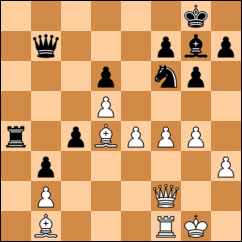
Time now to move forward on the kingside to try to get the initiative back.
27. g5
Our electronic ally prefers 27. f5 to get the f-file open.
27. ... Ne8
28. h4 Bxd4
29. Qxd4 Qa7
Removing the queen blunts much of White's attack.
30. Qxa7 Rxa7
31. e5 Rc7
32. Kg2
With some lateral defence in mind.
32. .... c3
33. bxc3 Rxc3
34. Rf3 Rxf3
35. Kxf3
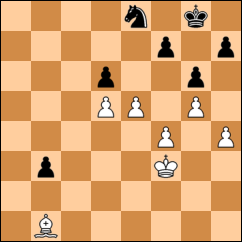
So welcome to the ending. Bishop and five pawns v knight and five pawns. My positive points here are that I have one pawn island all lined up, my king is slightly more active, and there is a possibility of a passed pawn in the centre. Black has the advantage of a forwarded passed pawn already and a knight which can jump about and cause havoc amongst my advanced pawns. If my king decided to stroll over to pick up the b-pawn, it is difficult to see how I can defend those pawns.
35. ... Kf8
36. Ke4
If Kg4 then Ng7 and I could not see anywhere to go from there.
36. ... Ke7
37. f5?
37. Kd4 is better. 37. .. Ng7 38. Kc3 b2 39. Kxb2 Nf5 40. Kc3 Nxh4 41. Be4. I should get at least a draw from there.
37. ... dxe5
38. Kxe5 Nd6
39. fxg6 hxg6
Now I was worried. That pesky knight seemed to have the whole board at its command.
40. Bd3 b2
41. Kd4 Nf5
41. ... Nb5+ looks good but 42. Ke5 Nc3 43. d6+ Ke8 44. Kf6 saves White as a timely d7+ will result in picking up the last two black pawns. Instead the knight goes the other way.
If now 42. Kc3 Nxh4 43. Kxb2 Nf3 and the g-pawn falls. The only thing I could think of was to get some sort of blockade by using the d-pawn as a diversion and getting the king in to sweep up the pawns as indicated. Then I could sac the bishop for the b-pawn and job done.
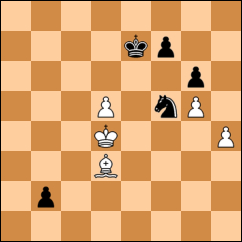
42. Ke5 Nxh4
43. d6+ Kd7
44. Kf6
44. Bb5+ Kd8 45. Bd3 Nf3+ 46. Kf6 Kd7 47. Kxf7 Nh4 - similar to the game but his king is further back.
44. ... Kxd6
45. Kxf7 Ke5
46. Bb1 Kf4
47. Kf6 Nf3
48. Kxg6 Nxg5
With the pawn where it is, the bishop has little room for manoeuvre and Black finishes perfectly. I am not sure 48. Bxg6 which keeps the king one square nearer makes much difference.
49. Kf6 Ne4+
50. Ke6 Nc3
51. Bc2 Ke3
52. Ke5 Kd2
53. Bg6 Na2
If now 54. Kd4 Nb4 55. Bb1 Kc1 or 55. Kc4 Nc2.
54. Bb1 Nb4
55. Kd4 Kc1
56. Resigns
Of course if the bishop moves eastwards then Nc2.
A second consecutive endgame defeat and just as disappointing. The turning point was the advance of the b-pawn although I felt I should have held the ending.
No comments:
Post a Comment